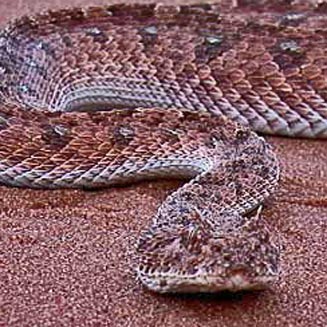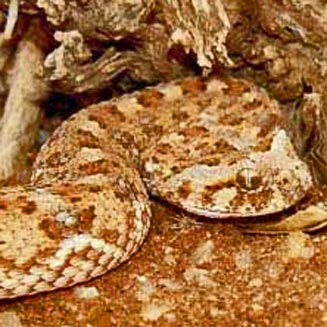|
Bitis caudalis (Horned adder or Side winding adder)
Horingadder, Horingsman [Afrikaans]; inDlondlo [Ndebele];
Shaushawane, sheushewane [Tswana]; Tshitemahe [Venda].
Life >
Eukaryotes
>
Opisthokonta >
Metazoa
(animals) > Bilateria > Deuterostomia >
Chordata >
Craniata > Vertebrata (vertebrates) > Gnathostomata (jawed vertebrates) >
Teleostomi (teleost fish) > Osteichthyes (bony fish) > Class:
Sarcopterygii (lobe-finned fish) > Stegocephalia (terrestrial vertebrates) >
Tetrapoda
(four-legged vertebrates) > Reptiliomorpha > Amniota >
Reptilia (reptiles) >
Romeriida > Diapsida > Lepidosauromorpha > Lepidosauria >
Squamata > Serpentes
(snakes) > Family: Viperidae > Genus:
Bitis
 |
 |
|
Bitis caudalis (Horned adder or Side winding adder), Northern Cape
(I. Scammel © from
SARCA
Virtual Museum] |
Bitis caudalis (Horned adder or Side winding adder), Northern Cape [Le Roux & Wolfhaardt
© from
SARCA
Virtual Museum] |
Identification
Can be easily identified by three rows of spots down the length
of its body, an hourglass marking on the head, a single horn above each eye and
its habit of concealing its body in loose sand. It grows to an average length of
40 cm but may reach 60 cm.
Distribution and habitat
The Horned adder is found in the following areas; the
Northern Cape, the eastern part of the Western Cape, the North West province,
northern Limpopo, parts of Zimbabwe, Botswana and most of Namibia. Its favoured
habitats include the Namib desert, Karoo scrub and arid savanna.
Food
Feeds on lizards (e.g. geckos and skinks), small
rodents
(e.g.
rats and
mice), birds
and
frogs.
Predators, parasites and disease
This adder species is fed on by
birds of
prey (including
secretary birds and
snake eagles) and other snakes. It is also threatened by humans who remove
it from its natural habitat.
Reproduction
Viviparous (gives birth to live young; three to eight young
are born in summer or early autumn.
Longevity
Can live for ten years or more.
Medical importance
Has dangerous cytotoxic venom which
although non-lethal can cause tissue damage. Antivenom is not available and
would be unnecessary even if it were.
Links
References
-
Broadley, D.G. 1983. FitzSimons' Snakes of Southern
Africa. Delta Books, Johannesburg.
-
Marais, J. 2004. A Complete Guide to Snakes of Southern Africa.
Struik Publishing, Cape Town.
|
